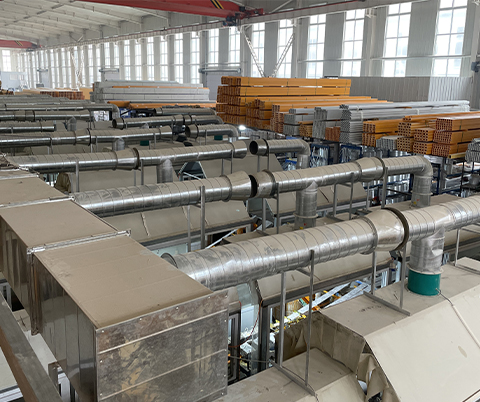loading...
- No. 9, Xingyuan South Street, Dongwaihuan Road, Zaoqiang County, Hengshui, Hebei, China
- admin@zjcomposites.com
- +86 15097380338
- Welcome to visit our website!
structural frp
Understanding Structural FRP A Revolution in Construction Materials
In the realm of modern construction and civil engineering, the demand for innovative materials that can withstand the rigors of time, environment, and heavy usage has never been greater. One such advancement is the utilization of Fiber Reinforced Polymer (FRP) composites, which have emerged as a transformative solution in structural applications. This article will explore the characteristics, benefits, applications, and future of structural FRP.
What is Structural FRP?
Fiber Reinforced Polymer (FRP) is a composite material made of a polymer matrix reinforced with fibers, such as glass, carbon, or aramid. The combination of these materials results in a lightweight yet exceptionally strong and durable product. Structural FRP is primarily used in building and civil infrastructure applications due to its high strength-to-weight ratio, corrosion resistance, and versatility.
Advantages of Structural FRP
1. Lightweight One of the most significant advantages of FRP is its lightweight nature. Compared to traditional materials like steel and concrete, FRP is significantly lighter, which simplifies transportation and installation processes. This characteristic also allows for reduced dead loads on structures, making it an ideal choice for retrofitting and strengthening existing buildings.
2. Corrosion Resistance Structural FRP is inherently resistant to corrosion, which makes it particularly beneficial in environments exposed to moisture, chemicals, or saline conditions. Unlike steel, which can rust and degrade over time, FRP maintains its integrity, resulting in lower maintenance costs and extended service life.
3. High Strength FRP composites exhibit excellent tensile strength, often surpassing that of steel. This property allows engineers to design slimmer structures without compromising on strength, which can lead to more aesthetically pleasing architectural designs.
4. Versatility The applicability of FRP ranges widely across various sectors, including bridges, buildings, industrial facilities, and recreational structures. Its ability to be molded into complex shapes and configurations makes FRP suitable for both structural and non-structural components.
5. Reduced Thermal Conductivity FRP has low thermal conductivity, which can decrease energy loss in buildings. This is particularly advantageous in environments where temperature control is essential, enhancing the overall energy efficiency of the structure.
structural frp

Applications of Structural FRP
Structural FRP is making waves in several areas
- Bridge Construction Many modern bridges now incorporate FRP components due to their lightweight properties and resistance to environmental factors. For instance, FRP has been used in both pedestrian and vehicular bridges, enhancing longevity and reducing maintenance costs.
- Reinforcement of Concrete Structures In the rehabilitation of aging structures, FRP can be used as external reinforcement to strengthen beams and columns, providing an effective solution without the added weight of traditional materials.
- Building Facades The aesthetic flexibility and strength of FRP allow architects to create unique building facades that are not only visually appealing but also resistant to weathering and wear.
- Marine Applications With its incredible resistance to corrosion and the harsh marine environment, FRP is widely used in boat construction, docks, and piers ensuring longevity and durability against saltwater exposure.
The Future of Structural FRP
The future of structural FRP is bright, driven by advancements in manufacturing processes and increasing awareness of sustainable construction practices. Ongoing research into new fiber materials and formulations will likely enhance the performance characteristics of FRP composites. Moreover, as the construction industry seeks more eco-friendly solutions, the recyclability of FRP materials and their life cycle analysis are gaining attention, which could further propel their adoption.
In conclusion, Fiber Reinforced Polymer is revolutionizing the construction industry with its lightweight, durable, and versatile properties. As engineers and architects continue to explore its potential, we can expect to see FRP play an increasingly vital role in creating the infrastructures of tomorrow. Embracing this innovative material not only makes practical sense but also aligns with the industry's commitment to sustainable development.
-
The Rise of FRP Profiles: Strong, Lightweight, and Built to LastNewsJul.14,2025
-
SMC Panel Tanks: A Modern Water Storage Solution for All EnvironmentsNewsJul.14,2025
-
GRP Grating: A Modern Solution for Safe and Durable Access SystemsNewsJul.14,2025
-
Galvanized Steel Water Tanks: Durable, Reliable, and Ready for UseNewsJul.14,2025
-
FRP Mini Mesh Grating: The Safer, Smarter Flooring SolutionNewsJul.14,2025
-
Exploring FRP Vessels: Durable Solutions for Modern Fluid HandlingNewsJul.14,2025
-
GRP Structures: The Future of Lightweight, High-Performance EngineeringNewsJun.20,2025
